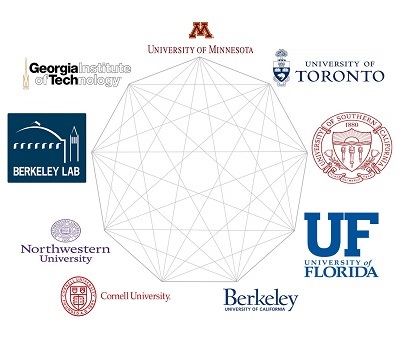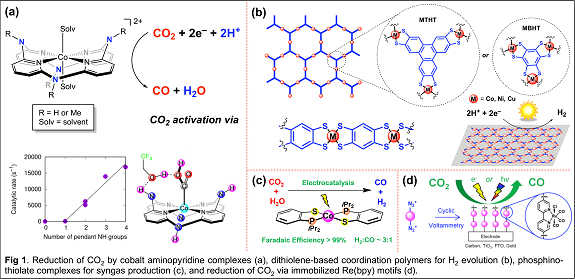






In response to increasing global energy demand and climate change driven by the consumption of fossil fuels, the development of clean energy technologies is paramount. A sustainable energy future will require a non-fossil fuel method for the formation of chemical feedstocks, and the electrochemical reduction of abundant natural sources, like H2O, CO2 and N2, using the solar-derived electricity is a viable pathway to do so. This approach will allow for storing of solar energy in chemical bonds in a similar way as nature accomplishes through photosynthesis, where the energy of photons is used to drive the reduction of CO2 to a variety of high-energy products. Nature uses metalloproteins to activate H2O, CO2, or N2. The protein matrix controls the coordination environment around the metal sites by generating multi-metallic or proton relay motifs, which lower the activation barrier and allow these difficult transformations to be performed efficiently.
The Marinescu group focuses on fundamental research to understand, design, and synthesize novel catalytic systems essential to the development of efficient solar-to-fuel technologies. Inspired by biological systems, we develop molecular catalysts that involve hydrogen bonding networks or multi-metallic motifs capable of small molecule activation by facilitating multiple proton and electron transfers. Given the scale of potential applications, we focus our studies on species that contain abundant elements, require benign (aqueous) solvents, and display high activity, selectivity, and stability during the catalytic process. We are also interested in the heterogenization of complexes via coordination polymers or covalent attachment to surfaces, which is important for large-scale applications. To these ends we developed coordination complexes and polymers that display unique activity towards the activation of small molecules, such as H2O and CO2.

Studies in the Marinescu group have shown that cobalt complexes with pendant secondary amine (NH) moieties act as highly efficient electrocatalysts for the reduction of CO2 to CO, and the proposed mechanism involves the formation of a hydrogen-bonding network intermediate that enables direct proton transfer from acid to the activated CO2 substrate (Fig 1a). In addition to CO2 reduction, we also developed catalytic systems for the conversion of water into H2 , such as the dithiolene-based coordination complexes and polymers (Fig 1b) that display remarkable electrocatalytic activity for the hydrogen evolution reaction (HER). We have also shown that a cobalt phosphinothiolate complex catalyzes the electrochemical reduction of CO2 to a mixture of H2 and CO (syngas) in the ratio of ~3:1 with excellent Faradaic Efficiencies (Fig 1c). We have also explored the immobilization of well-known CO2 -reduction catalysts, such as metal porphyrins or rhenium bipyridine tricarbonyl moieties, via incorporation into covalent-organic frameworks or via covalent attachment through robust diazonium reductive coupling (Fig 1d).
The robust and novel methods to heterogenize molecular complexes developed in the Marinescu group have the long-term aim of bridging the gap between homogeneous and heterogeneous catalysis and leading to the formation of efficient electrocatalytic materials. Moreover, the molecular nature of the developed systems offers excellent control over structure, which allows us to systematically tune important catalytic metrics such as mechanistic pathways, overpotential, stability, activity, and physical properties aiding in the development of efficient catalytic systems for the conversion of solar energy into chemical bonds.
Researchers in the Marinescu group will become experts in the synthesis and characterization of organic and inorganic species. Glove-boxes and Schlenk-lines will be routinely utilized for the synthesis and handling of air- and moisture-sensitive compounds. The characterization tools for the prepared complexes include NMR, IR, EPR, and UV-VIS spectroscopy and X-ray crystallography. The redox properties and catalytic activity of these species will be investigated by electrochemistry. The new electrode materials generated will be characterized by a variety of surface characterization techniques including SEM, TEM, XPS, and AFM.